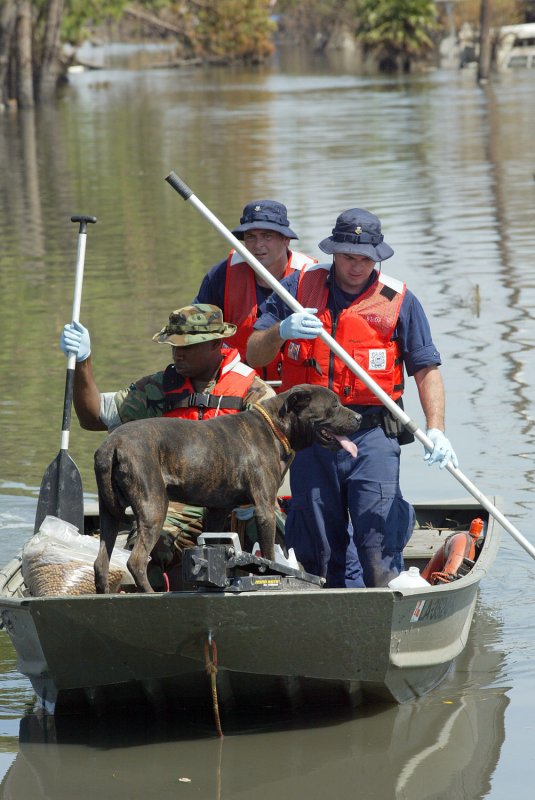U.S. Coast Guard members from Port Arthur, Texas, return to shore with a dog they rescued while on patrol in Lakeview, New Orleans, close to the 17th Street Canal levee breach on Sept. 11, 2005. Rescue personel continued to pull out people and pets nearly two weeks after Hurricane Katrina hit the Gulf Coast. (UPI Photo/A.J. Sisco) |
License Photo
As aftershocks and danger from the March 11 earthquake continue to rock Japan, animal welfare organizations have moved to help displaced pets.
Anyone who saw the heart-rending video of a brown and white dog leading human rescuers to another injured dog just after the 9-magnitude quake and devastating tsunami can only marvel at the courage and loyalty of animals. A group called World Vets is working with U.S. Army veterinary associates and animal charities based in Japan to help save pets left homeless by the disaster.
The earthquake, tsunami and possible meltdown at a damaged nuclear power plant was a triple catastrophe for both man and animal, with upwards of 20,000 people presumed dead or missing. While there has been no official estimate of the number of displaced pets, Animal Refuge Kansai rescued some 600 animals after the Kobe earthquake in 1995, Care2, an online animal rescue community, said.
"Here at ARK we are preparing for what might be a huge influx of animals. We already have some facilities in place and a team of experienced staff able to deal with traumatized animals. We may have to build animal shelters as well," Elizabeth Oliver, chairwoman of Animal Refuge Kansai, told Care2 days after the disaster.
Many animal welfare groups that had worked in Japan for years joined Japan Earthquake Animal Rescue and Support to provide shelter space for pets and reunite them with their owners, if they survived. World Vets, a 501(c)(3) non-profit based in Fargo, N.D., said on its Facebook page it is in Japan for the long haul, and is prepared to provide assistance to Japanese veterinarians in the Sendai area for months and years.
Closer to home, the American Society for the Prevention of Cruelty to Animals recommends all pet owners make provision for pets in their home emergency plans.
The ASPCA said pet owners store an emergency kit and leashes near a home exit, make sure all pets wear collars with up-to-date pet license and identification, consider mircochipping dogs and cats, always bring pets inside at the first sign of a storm or disaster, plan an evacuation route ahead of time and, at the first sign of disaster, make arrangements to board pets outside the disaster zone.
Don't have an emergency kit or plan ready? Take the time and make one for you and your pets.
A pet emergency kit should include a blanket, extra leash or harness, a week's supply of dry or canned food and bottled water, disposable litter trays and litter, recent photos of your pets, photocopies of medical records and a two-week supply of any medications pets require in a waterproof container.
If you must evacuate without your pets in an emergency place an "EVACUATED" sticker on the doors visible to rescue workers that includes the number and type of pets left inside. The information might give the pets a better chance of surviving.
In the meantime, keep yourself and your pets good health. A 2010 study commissioned by the Association for Pet Obesity Prevention found 20 percent of America's 171 million dogs and cats are fat, up 10 percent from a similar study in 2007.
"We just keep seeing more and more overweight pets," Fort Lauderdale, Fla., veterinarian Jesus Aramendi said in the South Florida Sun-Sentinel. "Some owners recognize it, but others don't. Or they are just in denial."
Many pets are pigs, wolfing down everything they can get in their mouths, but you rarely see a pet owner who underfeeds a pet, Cooper City, Fla., vet Robert Schachner told the Sun-Sentinel.
"In their natural makeup, they'd eat only once every week or two weeks, and that was in a pack. Then they eat all they can. They're gluttonous by nature."
But there is hope in the human-animal connection. A Michigan State University researcher found people who own and walk their dogs were 34 percent more likely to meet federal guidelines for physical activity.
Dog walkers generally walked nearly an hour longer per week than non-dog walkers. Public health guidelines issued by the Centers of Disease Control and Prevention recommend a minimum of 2.5 hours of moderate to vigorous aerobic physical activity a week, like playing sports, dancing, conditioning exercise, gardening and, of course, walking.
"Walking is the most accessible form of physical activity available to people," MSU epidemiologist Matthew Reeves said in a release for the study published in the Journal of Physical Activity and Health. "There is no magic bullet in getting people to reach those benchmarks," he said. "But owning and walking a dog has a measurable impact."















